A look at the Wirehaired Pointing Griffon.
By M.J. Nelson
When you think of the Netherlands, a lot of things spring to mind: windmills, dikes, tulips, Hans Brinker skating down a frozen canal. What does not come to mind when considering this densely populated, low-lying country with its restrictive hunting and gun laws is a fine pointing dog breed. Yet that's what Holland has given to hunters in the form of the wirehaired pointing griffon. Although the name "griffon" is French, the WPG is pure Dutch in origin.
Griffon History
While references to "griffons" can be found in historical documents dating back to 1545, the development of the modern day WPG actually began in 1853 when a young Dutch sportsman and an avid hunter named Eduard Karel Korthals set out to create what he considered to be the perfect foot hunter's dog. The WPG, or Korthals' griffon as it was known in the early days, was developed to be a hardy, close-working dog capable of working in the polders, the marshy low-lying ground common to the Netherlands.
The WPG came equipped with a coat that was able to withstand just about anything the North Sea chose to throw at it, with colors that blended well with the natural background of the polders when the dog and his partner were hunting waterfowl or sneaking up on fur-bearing game.
The breed was introduced in the United States in the late 19th century, and it remained pretty much as Korthals developed it until the mid-1980s, when a North American group, believing the griffon needed an infusion of "outside" blood to bolster deteriorating hunting instincts, decided to cross their dogs with the Cesky Fousek, a similar-looking breed from Czechoslovakia with a hunting style similar to the German wirehaired pointer.
But WPG purists, affiliated with the American Kennel Club and/or the North American Versatile Hunting Dog Association (NAVHDA), resisted altering Korthals' vision and purpose.
They concluded that the crossbred offspring of WPGs and Fouseks were no longer true griffons and in 1991 the AKC agreed, recognizing the second group, who made up the American Wirehaired Pointing Griffon Association, as the parent club for the WPG in the U.S.
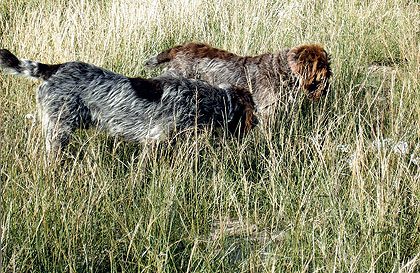 Ch. Birdfinder's Snowbird ("Sophie"), one of Hank and Sue Brandes' WPGs, has the point. Backing is another of their dogs, Ch. Mickey de Baron JH. Sophie has a UPT from NAVHDA in addition to her conformation championship from AKC. Mick also has a Prize II in natural ability from NAVHDA. |
Furthermore, a whole host of organizations ranging from the three major kennel clubs in North America (American Kennel Club, United Kennel Club, Canadian Kennel Club) along with the Fédération Cynologique Internationale, North American Versatile Hunting Dog Association, American Field and the European Griffon and Fousek organizations, refused registration and testing of the crossbred Griffon/Fousek. The basic philosophical difference between WPG purists and Griffon/Fousek people remains unresolved today.
While there is no absolute certainty about how Korthals developed the patriarchs of the breed, the ancestry of the true griffons may have been an ancient breed called the Griffon Hound. At least one reference in the breed's development is made to a "pointer" and it has been speculated that this referred to either the Braque Français or the German shorthair.
Other sources argue that the contributors to Korthals' breed included spaniels, Otterhounds, the French Barbet (a water retriever) and a setter. Adding even further to the confusion is the fact that in historical Europe, many different breeds of dogs that had facial furnishings and wire coats were simply called "griffons" and many breeds today are still known generically as "griffons," including the Spinone Italiano.
All of these breeds, like setters (Irish, English, Gordon) and retrievers (Chesapeake, golden, Labrador, flat-coat, curly-coat) are correctly called "griffons" even though, like the breeds that make up the setters and retrievers, they are separate and distinct breeds.
Rare Breed
The WPG is a relatively rare breed among sporting dogs. Only 410 were registered with the AKC in 2005 and while this is up about 40 registrations from the previous year, finding a WPG pup is not an easy task. Even with the "population increase" last year, a total of only 88 litters were registered in the entire country in 2005.
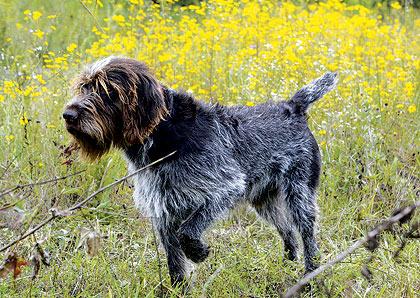 Buddy (VC Ch. Alibi's Montana Gold MH), Pat Loomis' WPG, winds a bird and hits a point. |
This is definitely a walking hunter's breed, a fact that endears it to Hank Brandes. "A griff makes an ideal gun dog for those of us in the 'senior set.' I'm just shy of 72 and my griffs have slowed down for me so I can still keep up and hunt with them," Brandes notes. "I started hunting behind griffs that were owned by my brother and his friends in Iowa some 25-plus years ago," Brandes continues.
"They also had German shorthairs and my brother had an English setter. One problem I noted with these dogs was that while they worked hard, fast and furious, they burned themselves out in about two to three hours, whereas the griffs, being slower and more methodical in their work, worked all day and were ready to go the next day and the day after that and the day after that.
"Furthermore, they were pointing just as many birds as the fast workers. They're also very biddable and do not require a lot of training other than putting birds in front of them if your interest is limited to simply going out and getting pheasants."
Training A WPG
If your desire is for something more, however, the training can be a bit more complicated.
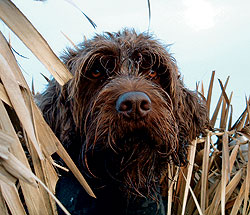 Like her namesake, Jon Pease's WPG, Ch. Alibi's Pin Up Girl Greta Garbo JH NA1 ("Greta") has a memorable face indeed. |
"The WPG is not the easiest dog to train to the highest levels," says Philippe Roca, who currently serves as vice president of the American Wirehaired Pointing
Griffon Association. "When you run into folks who tell you that the breed is easy to train, you should ask how many they have trained to the UT1 or the Master Hunter level. Griffons are difficult to train to these levels because they are too smart and too soft, particularly if you have not done the right things with them.
"They have tons of natural ability and they always figure a way out," continues Roca. "I have trained several breeds besides griffons and griffons require a totally different approach. The average pro trainer does not want to mess with them, and as a result there are only a couple in the country who are having good results with them in competitive events. "The problem is the time factor," Roca continues. "You simply cannot rush a griffon.
They do things on their own schedule...maybe. But when you get a good one, you need nothing but a gun and some shells. Of course, you also need to be a respectable wingshooter because they won't hesitate to give you dirty looks if you miss."
Jon Pease, the president of the AWPGA, agreed that the breed is not the easiest to train. "The griff is difficult to train but actually no harder than any of the versatile breeds," he says. "You have to understand the temperament of this breed. If you push them too hard, you scrap the dog. They are a thinking breed, not a charging breed.
"You also have to train a griff for the unexpected. An example would be when training for the NAVHDA UT test. On the drag portion of the test, a judge is positioned in the woods to witness the end of the drag. A shorthair will follow the track and retrieve the game without noticing the judge. If you send a griff on that same track, they most assuredly will notice the judge and oftentimes will bark at the judge or turn and leave without the game.
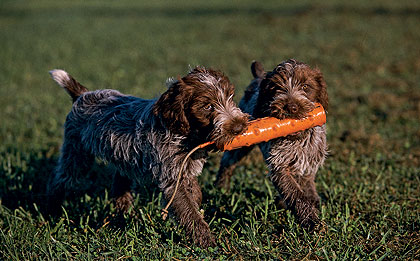 Griffon puppies are lively and possess plenty of hunting and retrieving instinct. |
"What this means is that when training for this test you have to make sure you have someone in the woods, and there are a number of other situations where you have to do additional training or take additional precautions with a griff. A griff will not tolerate a heavy hand or over-correction. You can use an electronic collar on them but only if they are properly conditioned and you use only the mildest of settings for correction.
Chuck and Karen Speiss do a lot of different things with their WPGs and they noted that one problem in training this breed is that they do not take kindly to a lot of repetition.
"They learn very quickly, which means that repeating something once or twice is okay but by the third time, they are thinking they have done something wrong and they start messing up," says Chuck.
"The solution to this is to go on to something else and then come back to what you were originally doing," Chuck continues. "Then they will do it correctly again. When the hunting seasons are closed, we train our dogs for tracking, agility and obedience. It helps keep them from getting bored as well as keeping them in shape physically."
"This is generally not a good breed for the first-time dog owner," says griffon fancier Vicki Foster. "They are very smart and sensitive to their owner's moods and desires. If the owner/trainer is knowledgeable and consistent in their training programs, griffons learn very quickly."
Pat Loomis noted that it helps to have a keen sense of humor when you train a griffon.
"You need to be able to laugh at yourself and the dog to successfully train a griffon. They are a happy breed that loves to have fun but they do need discipline. They see everything that's going on and notice anything that is different.
"Usually a verbal scolding is enough to crumple any griffon and they take corrections quite well if they know why they're being corrected. They adore their families and will do anything to please the members of their family. However, this love for their family means that griffons need to be around people, which is why they don't do very well in a kennel situation."
Hunting With A WPG
The breed has a great deal to recommend it as a hunting dog, Loomis says. "They are a close-working dog, which makes them ideal for the walking hunter. They are thorough and great at picking up singles. They will go through the thickest brush to retrieve a bird and they will sit in the blind with you quietly until their whiskers are frozen waiting for the ducks to come.
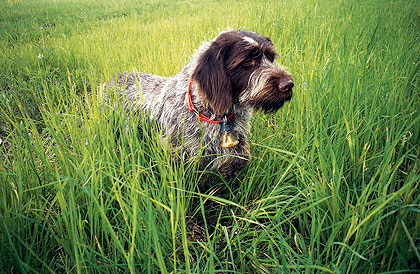 Ch. Oak du Mas du Jonquier, owned by Philippe Roca, holds a perfect score (112 points) in NAVHDA Natural Ability and a NAVHDA Utility Prize II. |
They love to retrieve from the water and their double coat allows them to withstand cold water. You can hunt ducks in the morning and woodcock in the afternoon with them. If you shoot it, they'll bring it back."
Jon Pease noted that he has hunted in many different states for a variety of game with his griffons and they have been effective wherever and whatever he is hunting. "I use my dogs for all types of game. We regularly hunt ducks and we travel to hunt quail, pheasant, chukar and grouse. I've hunted the highlands of Idaho, the forests of Wisconsin, the open fields of the upper Midwest and the flooded timber and rice fields of the Delta.
"The griff is definitely a great dog for walking hunters because they will hunt close all day long with their effortless gait. They work ground methodically and efficiently and they will often find game that the faster pointers and setters have blown by. But this is a breed that really has to have a job, as they are easily bored."
Do Your Homework
It is important to do some serious homework before you buy a puppy. First you need to find a litter from a reputable breeder. The American Wirehaired Pointing Griffon Association maintains a breeder referral program (www.awpga.com) but it is still important to scrutinize breeders even if they appear on the list.
"I would advise people looking for a griffon puppy to do their research and go to a reputable breeder," says Pat Loomis. "Make sure the parents have been tested by one of the hunting organizations and if possible, you should meet the parents of the pups. Make sure OFA or PennHip have given the parents' hips a passing grade. Finally, make sure the puppy has a good temperament. There are griffons being bred with temperaments that are not typical of the breed."
For those seeking a purebred griffon, Philippe Roca cautions against buying what he calls a "Foufon" (a Fousek/griffon cro
ss), as these dogs are not eligible for registration or testing by any of the major North American stud books.
"If you are buying a pup from a North American breeder, watch out for those people who tell you that the litter is registered but cannot produce litter or individual registration papers from the AKC, the FDSB, the UKC, the CKC or NAVHDA," Roca states. "The Wirehaired Pointing Griffon Club of America, which is the group that promotes the 'Foufon,' has created its own registry, written its own standard and conducts its own field trials."
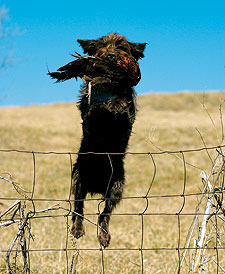 Tribble (Ch. Kyloe's Trekking K.B. Tribbles, with CD JH CGC NAVHDA Prize III) one of Chuck and Karen Speiss' WPGs, says, "The bird's right here!" |
Brandes worries that the breed is becoming more popular--especially among outdoor enthusiasts who may not be hunters. "We see more and more griffs being owned by hikers, bicyclers, mountain climbers and others who aren't hunters," he notes. "This is not a good trend for the breed as these dogs are hunting dogs. I'm also concerned about people who buy a male and a female and start raising puppies simply because this is an unusual breed that has shown a rise in demand."
Vicki Foster agrees. "I think the breed's rarity attracts the wrong type of people--those looking for 'something different.' The griffon was developed as a hunting dog and should remain in the hands and care of those who will keep it as is--a supreme hunting dog."
Chuck Speiss noted that a major challenge facing WPG breeders is keeping the show and hunting aspect of the griff in the same dog. "We don't want to go the way of other sporting and hound breeds, where the show dog is totally different than the hunting dog.
We are seeing more and more griffs in the show ring that are oversized and over-groomed. The griff is one of the smaller of the versatile hunting dogs and they should be kept that way.
"Also, their coats are very low maintenance, which means that you shouldn't be doing a lot of grooming before you take the dog into the show ring. On the other hand, breeders who breed with only fieldwork in mind must pay attention to conformation. You can have the best hunting dog in the world but if the dog has poor angulation or proper structure is not there, the dog won't hunt very long."
"My first piece of advice for anyone looking for a griff is 'buyer beware,'" says Pease. "I suggest looking for a dog from proven hunting stock. The parents should be titled in the field and I also suggest that they look for pups from dogs that are conformation champions.
"A dog that has correct conformation makes a more useful hunting partner. There are a number of griffon breeders in North America who have conformation and field-titled dogs. You also need to check health clearances. Hips and thyroid problems are issues for this breed.
"One of the greatest challenges facing us at the moment is the temptation for breeders to seek financial rewards rather than focusing on quality," continues Pease. "We have a limited gene pool and we must be good stewards for our breed."






